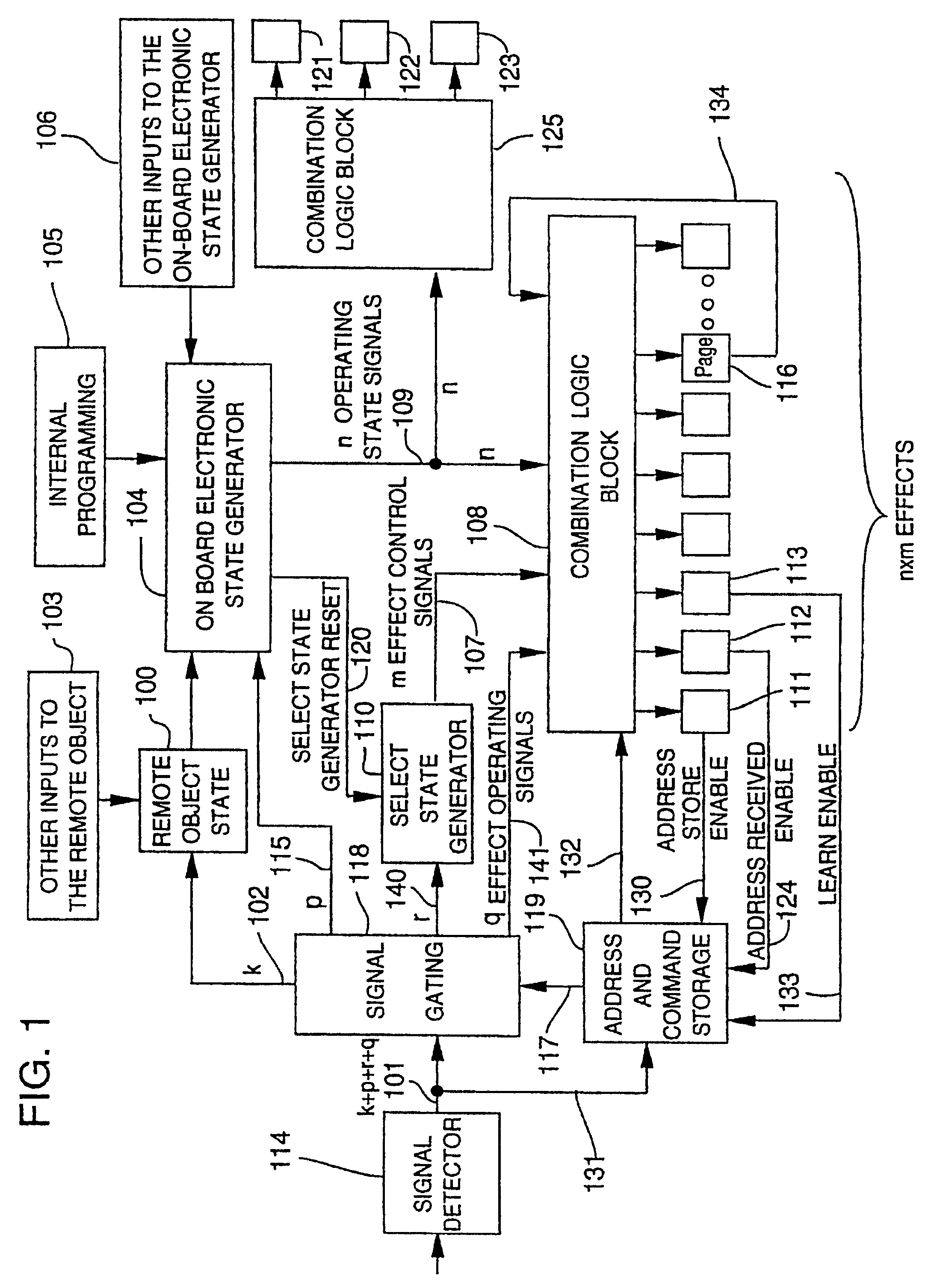[0033]The direction
control switch, 304, in FIG. 3, which normally is only used to change the direction of the engine by changing the polarity of
DC voltage on the track, can be used to do simple
remote control operations under certain conditions. This new remote
control signal will be called, PR, for Polarity Reversal. The on-board
motor controller, 402, supplies a specific polarity of
voltage to the motors independent of the polarity of the track
voltage on rails 307 and 308. That is, the
motor controller, 402, can prevent the engine from changing direction when the direction switch, 304, is toggled between position A and B, 305 and 306. Instead, the on-board state generator will specify the motor direction to the
motor controller, 402. Direction changes will be made by changing the OBSG state using other remote control signals or even combinations of signals that may involve PR signals and possibly by the state of on-board state generator, 405.
[0034]Having this one single remote
control signal, PR, plus an on-board state generator and a motor controller that can be programmed to interpret this signal can improve the operation of DC-powered trains in a number of ways. For instance, when power is applied to the engine, toggling the direction switch, 304, on the track power-pack could actuate a remote control feature like blowing the horn but will not cause the engine's direction to change. However, changing direction of an engine could be done in the normal way with a minor limitation: if the engine is stopped by turning the power off and the direction
control switch, 304, is toggled, reapplying the power could cause the direction of the engine to change. In this way, the direction switch, 304, would still provide the familiar operation control that is standard for DC powered trains. This is a very natural use of the direction switch since the DC
train operator is not in the
habit of using the direction switch to change direction while an engine is moving; otherwise it causes an abrupt reversal of his locomotive which is very unrealistic and may damage the engine or, at least, cause a
train derailment. Hence, changing track polarity while the engine is moving is a new operation that can be used for remote control functions without violating the normal operating standard.
[0035]Other features like turning on and off the bell can be done by using a coded signal such as changing DC track polarity for two long and one short period of time or perhaps a
short duration of changing DC track polarity will turn on or off the bell while a long duration of changing DC track power will blow the whistle. Or the bell can be turned on or off if a polarity reversal is used while the track
voltage is low but a PR will turn on the horn if the track voltage is high.
[0041]This method of making a selection with one remote signal and operating it with another is very simple for either AC or DC
power model engines in neutral. If reset is a non-moving state, using this technique is ideal for initializing the operation of an engine such as starting the engine sounds, turning on various lights, etc. For instance, imagine that we moved the
throttle up and down a total of six times (6 HVP's) after entering reset which changes the OBSG to a state called “engine sound volume”. Then, the second remote
control signal could be used to change the volume from the present value to progressively lower values until it returned to the highest value in a continuous loop. Moving the
throttle up and down again at any of the
volume setting would lock-in the volume choice and move to the next state of the OBSG for another option. For instance, this next option could be “overhead blinking light”. Now, toggling the second remote control signal could be used to toggle the light between on and off. This approach of selecting and operating different options could proceed indefinitely. Again, the use of the OBSG increases the number of remote control options.
[0042]It is, in fact, possible to
nest sets of options so the
list of options does not become too unwieldy. For example, the in Reset option 12, operating the option could perform “page advance”. The next option available to the operator might then be Page 2 / Reset option 1. Now, repeated uses of HVP would advance through Page 2 options. Option 13 on every page (higher than page 1) could be “return to page 1 options”. Nesting like this can produce any number of pages with any number of options per page in a way that is easy for the operator to use.Other
Remote Control Signals for Engines, Cars and Accessories on DC Powered Layouts
[0046]This invention describes new remote control signals that can be easily generated within the existing DC powered model train standard and how these signals can be used with an on-board state generator in the
remote object (usually an engine) to expand remote control operations. In particular, when two remote control signals are available, the idea of “select” and “operate” can be used to simplify remote control operations.
 Login to View More
Login to View More  Login to View More
Login to View More 


